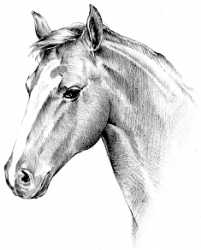The horse's purchase visit
 After practicing riding for a while, many riders want to acquire a horse. For the lucky, and most affluent, the dream can become reality. But beware, a horse is a demanding animal.
After practicing riding for a while, many riders want to acquire a horse. For the lucky, and most affluent, the dream can become reality. But beware, a horse is a demanding animal.
It must be dealt with every day, even in bad weather, even if one is tired, etc… financially, This is an important commitment : Moreover costs “housing”, fitting, power, etc… must be able to assume the veterinary costs, especially in times of hardship (for example, a colic surgery can cost between € 3000 and € 4000).
To buy a horse, there are several solutions : on a farm (if we want to compete or reproduction, etc…), in particular, in a riding club (if one is attached to a horse), or with horse traders. Each solution has its advantages and disadvantages. In all cases, it is better to be accompanied by someone who knows horses (for example his monitor) especially if you have a doubt about the quality or health of the horse : there are a lot of scams malheureusment in selling horses ! It will always ask to see the horse outside, clean, moving, and if possible try.
The papersThe seller must give you the booklet (that contains origins, reporting and vaccination certificates) and owner card. It must assume the title, because the horse booklet does not designate you as owner, it is the card that the. The instructions for your name to be registered as a new owner on documents. This card is also a guarantee that the seller is the owner of the horse.
The purchase visitIt is very important to make a purchase visit by a veterinarian before buying animals for good. Indeed, the visit can highlight pathologies, or premises of undetectable disease at 1 First (it is obvious that this visit will not indipsensable if you want to buy a horse club 20 years to get pre and offer him a happy retirement). Be aware that some diseases, rhédibitoires called vices, may cancel the sale, in a delay of 30 days in general .
The veterinarian will first examine the horse stopped (conformation, condition, no sores or lesions visible externally, aplombs…) and check that the booklet is reporting. Then he made a full clinical examination : cardiac auscultation, pulmonary, state mucosal, eye exam… Then comes static orthopedic examination (stopped) which consists of series of tests :
– test the gripper feet (detection sensitivity or a possible navicular disease) Bending tests of the joints (highlighting good mobility and freedom from pain)
– Expansion joints testing
– test mobility of the patella (some horses to hang, they are then stuck with the rear extension)
– check the flexibility of the column, absence of heat in the vertebrae…
Then the horse is examined in motion : it is the dynamic orthopedic examination. The vet looks at the trot in a straight line on a hard floor (1'round trip), then again curls, but keeping each flexed hinge 1 mn. The horse trotted off again immediately. If the pace is similar before and after bending, test negative, otherwise it is positive and indicates a problem with the joint tested or neighboring structures.
Then, looking at the horse on a circle, to the 2 hands, on hard ground to detect joint problems, or bone lesions in the foot, then soft ground to detect tendon or muscle problems. We made him do an eight on hard ground and moving joints are tested (Non-hooking). To do well, it is better to do x-rays, at least a minimum: forefeet (navicular disease), front and profile prior balls (detecting bone fragments called ships).
It is also recommended to make shots hocks (detecting éparvin, de ship, OA…). If the horse is found positive to one or more tests, you can refuse the animal, or request a deepening of the diagnosis whether the horse should still use you want to have (all this will be at your expense). After all these exams, the vet will advise on the purchase of the horse for your use.
